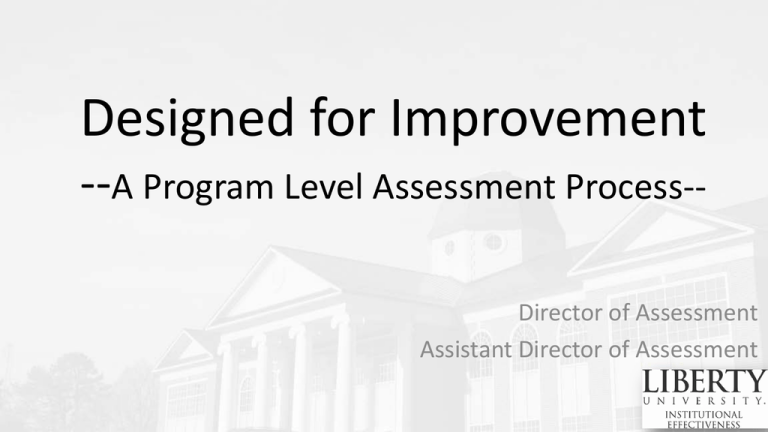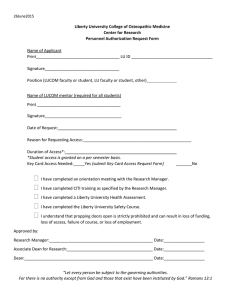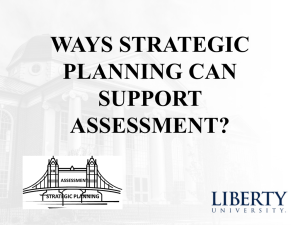Designed for Improvement -- A Program Level Assessment Process-- Director of Assessment
advertisement

Designed for Improvement --A Program Level Assessment Process-- Director of Assessment Assistant Director of Assessment Learning Outcomes • Understand the importance of an assessment process that leads toward improvement • Plan an outline for an assessment design (as presented) • Explain the process for using the results for improvement 60/60 - Pair and Share • Pair up, and share with your partner the following: – Name, Institution, Position – How does your institution conduct program learning outcomes assessment? • Processes? • Policies? • Procedures? Liberty University • Liberty University is the largest private, nonprofit four-year college in the country, the nation’s seventh largest university, and the largest college in Virginia. • Enrollment: Exceeds 100,000 students with nearly 13,000 resident students and more than 90,000 online students Liberty (continued) • INSTITUTIONAL ACCREDITATION: Southern Association of Colleges and Schools Commission on Colleges (SACSCOC) • TOP UNDERGRADUATE MAJORS: Business, Psychology, Religion, and Education • 315 unique programs (some both resident and online) – 206 RESIDENTIAL PROGRAMS OF STUDY: • 151 undergraduate, 54 graduate, 1 post master's – 166 ONLINE PROGRAMS OF STUDY: • 57 undergraduate, 100 graduate, 3 post master's, 6 doctorate Assessment and Evaluation OFFICE OF INSTITUTIONAL EFFECTIVENESS Assessment Roles • • • • • Facilitators Assessment Coordinators Chairs Deans Faculty Assessment, Analysis, and Improvement – Student program level learning outcomes assessment – Curriculum Design review – Program curricular review • • • • Major enrollment and graduation rates Facilities review Alumni satisfaction etc… Classroom Assessment/Improvement v. Program Assessment/Improvement SIDEBAR – CLASS OR PROGRAM Classroom Assessment and Improvement • The teacher of the senior capstone course evaluates her student’s final projects, assigns grades, and uses the information for her own improvement next semester (Walvoord, 2004) Program Assessment and Improvement • The faculty teaching the senior capstone report annually to the department, outlining the strengths and weaknesses of the students’ work in relation to the departmental learning goals. • The department uses these and other data, such as student and alumni data, to inform decisions about curriculum, pedagogy, and other factors that affect student learning (Walvoord, 2004) P-L-A-C-E Program and Learning Assessment Cycle for Excellence Assessment Scope and Process • Program learning outcomes and syllabi are assessed on a three-year cycle • Program curriculum is reviewed on a five-year cycle. • In addition to the course-embedded assessments, used primarily for student learning outcomes, the departments participate in an Annual Assessment Day each spring Systematic Plan/Process for Assessment Process -- Design Department IE Facilitator Dean • Completes PLO Design in Planning and Submits to IE. • Reviews the design with integrated feedback tool and submits to Dean • Other facilitators review comments as well. • Reviews PLO design with IE Facilitator's comments and adds additional instructive comments or questions Process -- Conduct -Conduct Assessment- Process - Report Chair/Assessment Coordinator • Updates assessment design and includes findings and action plan (if necessary) and submits to IE Facilitator IE Facilitator Dean • Reviews the design with integrated feedback tool and submits to Dean • Other facilitators review comments as well. • Receives final copy of the entire PLO assessment. Measuring Student Learning OUTCOMES ASSESSMENT The Logic of Assessment Mature Cycle of Data PLO Implementation Mature Cycle of Data Evidence Assessment Template • At Liberty, a standard Program Learning Outcome assessment template is utilized for all assessment designs. • By using a template, it is easier for faculty to ensure they have thought through all aspects of the design. What is Done with the Results? • Once the assessment is conducted, findings are reported in our assessment management system. • When findings are reported, there are checkboxes indicating “met,” “partially met,” or “not met.” Where Does Improvement Fit in? • For targets that are “not met” or “partially met,” an action plan is created to remedy the identified deficiency. • If the rubric/scoring key was designed well, it should be relatively easy to identify which sub-skill the students are deficient in. What are you doing with it…? Assessment and decision making should go hand in hand…In essence, assessment and improvement are often separated by a single important point: assessment focuses on the what, improvement on the what-you-do-with-it. Linking the two may very well be the most crucial aspect of successful assessment practice. (Banta, Lund, Black, & Oblander, 1996) Closing the Loop • Each action plan is given a due date as to the time expectation for the improvement to be carried out. • We try to encourage curriculum improvement decisions instead of an action plan which adjusts the assessment when a target is not met. Evidence of Improvement • Once the action plan is completed, the same assessment is carried out with a similar sample of students. • If improvement is demonstrated in an area which was previously deficient, this would be considered evidence of improvement. • Our assessment management system has a text box in which the evidence of improvement can be thoroughly explained. THANK YOU! References • Banta, T. W., Lund, J. P., Black, K. E., & Oblander, F. W. (1996). Assessment in Practice. San Francisco: Jossey-Bass. • Suskie, L. (2004). Assessing Student Learning. Bolton: Anker. • Walvoord, B. E. (2004). Assessment Clearn and Simple. San Francisco: Jossey-Bass.


